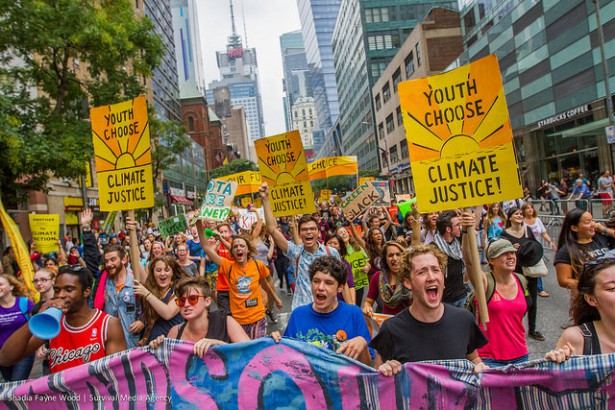
Thankfully, there’s no one story to be told about the People’s Climate March. There are a few facts, and many stories.
At 3:00 p.m., midway through the march, organizers estimated that 310,00 people had taken to the streets. The most recent numbers top 400,000. Meanwhile, police scanners reported up to 600,000 marching down 42nd Street from the gathering points along some 30 blocks up Central Park West. Solidarity actions were organized in 2,808 cities, across 166 countries.
Over 1,000 organizations endorsed the New York march, with much of the leadership provided by local grassroots organizing outfits like the Climate Justice Alliance and the Booklyn-based group UPROSE.
The People’s Climate March was, more or less, what it sounds like: a popular gathering of people from all walks of life vitally concerned about the climate crisis. In the context of the march, “climate crisis” isn’t a reference only to carbon emissions or rising sea levels. That the climate has taken a turn for the worst might be the most apocalyptic, but certainly not the first negative feedback from a model of economic development that’s left basically everyone who isn’t extraordinarily wealthy out in the cold.
Fittingly, then, the march was organized thematically into six sections that spanned 27 blocks. At the front of the march was a contingent called “Frontlines of Crisis, Forefront of Change” — made up of indigenous and environmental justice organizations and others who are the “first and most impacted” by climate change, as well as those “leading the change,” according to the march website.
The remaining sections each described the people marching in them: “We can build the future” (students, labor and families), “We have the solutions” (food and water justice, renewable energy), “We know who is responsible” (anti-corporate campaigns and faith and justice), “The debate is over” (scientists and interfaith groups), and — finally — “to change everything, we need everyone,” comprised of New York City boroughs, community groups, neighborhoods, cities, states, countries and more.
One participant, Sachie Hopkins Hayakawa of Philadelphia, said that she marched with the youth bloc because she “[believes] that the power and imagination of young people is fundamental to building the political will we need.”
The orange and blue hand-sewn sign held in front of the student bloc read, “What do you love?” In many ways, the march was as much a celebration as a challenge. There was no air of self-congratulation as people milled around the route’s end on 34th Street. Many walked away ready to join the Flood Wall Street action on Monday, or return back home to start or continue organizing in their communities.
Leaving the march, marchers seemed to share a sentiment voiced by Illiana Salazar-Dodge, a fossil fuel divestment organizer at Columbia University: “I’m part of a new climate movement that includes fighting racial oppression, immigrant oppression and economic injustice. And creating a new world.”

“I’m part of a new climate movement that includes fighting racial oppression, immigrant oppression and economic injustice. And creating a new world.”
Me too. I’m all in against racial oppression, immigrant oppression and economic injustice. My only reservation is that many people involved in the climate-change march do not understand the science of economics. Economics, rightly understood makes no value judgments, but it is critically important because it can tell you if the objective you are pursuing can be achieved by the means you are employing. The website, mises.org, has a substantial catalog of books and articles on all aspects of economics, climate change science and politics, environmental problems, etc.
Occupy The NEED Act is an educational coalition building a grassroots movement around an actual bill that would not #Audit but actually #endthefed as we know it and put the power of money creation #debtfree back into the US Treasury where it constitutionally belongs. This is a system change in the way money is made. No more private money. No more public debt. this ends trickle down economics and provides a way for publicly financed elections, universal basic income, a studen debt jubilee and so much more!
PLEASE google the National Emergency Employment Defense (NEED) Act, HR 2990 of the 112th congress, written by dennis kucininch before they kicked him out of congress – for THIS BILL! More info is available at monetary.org and https://www.facebook.com/occupytheneedact